
It’s been a long time coming and today Apple finally unveiled the all-new Mac Pro and yes it’s a tower, not a trash can. Here is what we know and it looks to be a beast.
With the all-new tower design, the new Mac Pro is very upgradable with eight PCI express slots. Two MPX Modules or up to four PCI Express card slots. I think it’s a huge improvement over the old cylinder design.
Apple has new hardware called Afterburner. It is an FPGA based accelerator. It will make the Mac Pro capable of playing three simultaneous 8K RAW video streams, or 12 4K streams. The card is capable of processing 6 billion pixels per second. Impressive
Apple’s new hardware will bring a mind-blowing level of performance to Metal-accelerated, proxy-free R3D workflows in Final Cut Pro X that editors truly have never seen before. We are very excited to bring a Metal-optimized version of R3D in September.
Jarred Land, president, Red Digital Cinema
Each MPX bay provides:
- x16 gen 3 bandwidth for graphics
- x8 gen 3 bandwidth for Thunderbolt
- x8 gen 3 bandwidth for Thunderbolt
- Up to 500W power for an MPX Module
Alternatively, each MPX bay can support:
- One full-length, double-wide x16 gen 3 slot and one full-length, double-wide x8 gen 3 slot (MPX bay 1)
- Or two full-length, double-wide x16 gen 3 slots (MPX bay 2)
- Up to 300W auxiliary power via two 8-pin connectors
Three full-length PCI Express gen 3 slots
- One x16 slot; two x8 slots
- 75W auxiliary power available
One half-length x4 PCI Express gen 3 slot with Apple I/O card installed
With up to 28 core Xeon processors, 56 teraflops of graphics performance and the new Afterburner card, the new Mac Pro delivers performance that will accelerate pro workflows. A number of pro app developers are seeing impressive results in a single workstation.
- Blackmagic Design brings full CPU and multi-GPU accelerated 8K real-time editing, effects and color correction in ProRes 4444 for the first time on any system.
- Avid can enable support for up to six HDX cards, resulting in more IO, increased voice count and two times the real-time DSP processing than any other system can achieve in Pro Tools.
- Maxon’s Cinema 4D is seeing 20 percent faster GPU render performance when compared to a Windows workstation, maxed out with three NVIDIA Quadro RTX 8000 graphics cards.
Configure from an 8‑core to 28‑core Intel Xeon W processor
8-Core
3.5GHz Intel Xeon W
8 cores, 16 threads
Turbo Boost up to 4.0GHz
24.5MB cache
Up to 1TB 2666MHz memory
12-Core
3.3GHz Intel Xeon W
12 cores, 24 threads
Turbo Boost up to 4.4GHz
31.25MB cache
Up to 1TB 2933MHz memory
16-Core
3.2GHz Intel Xeon W
16 cores, 32 threads
Turbo Boost up to 4.4GHz
38MB cache
Up to 1TB 2933MHz memory
24-Core
2.7GHz Intel Xeon W
24 cores, 48 threads
Turbo Boost up to 4.4GHz
57MB cache
Up to 2TB 2933MHz memory
28-Core
2.5GHz Intel Xeon W
28 cores, 56 threads
Turbo Boost up to 4.4GHz
66.5MB cache
Up to 2TB 2933MH memory
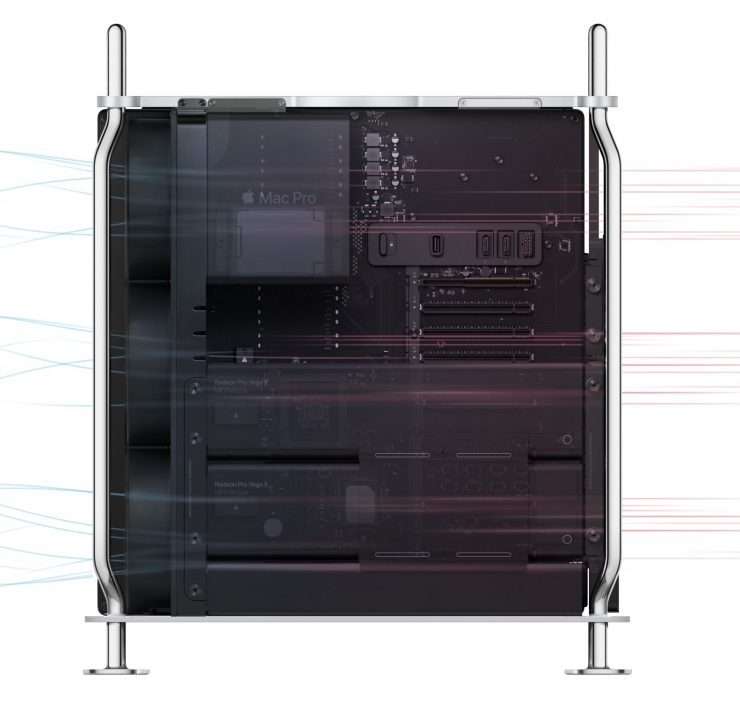
To keep it cool the new Mac Pro has three big and quiet fans to push air through the tower. On the opposite side, a blower pulls the air across the memory, storage and through the power supply, exhausting it out the back of the computer. Apple claims the fans are no louder than the iMac Pro.
To go with CPU horsepower the new Mac Pro also can be packed full with 12 user accessible DIMM slots for up to 1.5TB of Ram.
RAM Configuration
- 32GB – Four 8GB DIMMs
- 48GB – Six 8GB DIMMs
- 96GB – Six 16GB DIMMs
- 192GB – Six 32GB DIMMs
- 384GB – Six 64GB DIMMs
- 758GB – Six 128GB DIMMs or 12 64GB DIMMs
- 1.5TB – 12 128GB DIMMs (Requires 24-core or 28-core processor.)
- 8-core processor operates memory at 2666MHz.
12-core to 28-core processors operate memory at 2933MHz.
For GPU or GPU’s the new Mac Pro is keen on using AMD Radeon cards. Will Nvidia be an option? That will be up to Nvidia to have drivers available but as of now, the AMD offerings are what the Mac Pro will ship with. The options are the AMD Radeon Pro 580X, AMD Radeon Pro Vega II, and AMD Radeon Pro Vega II Duo.
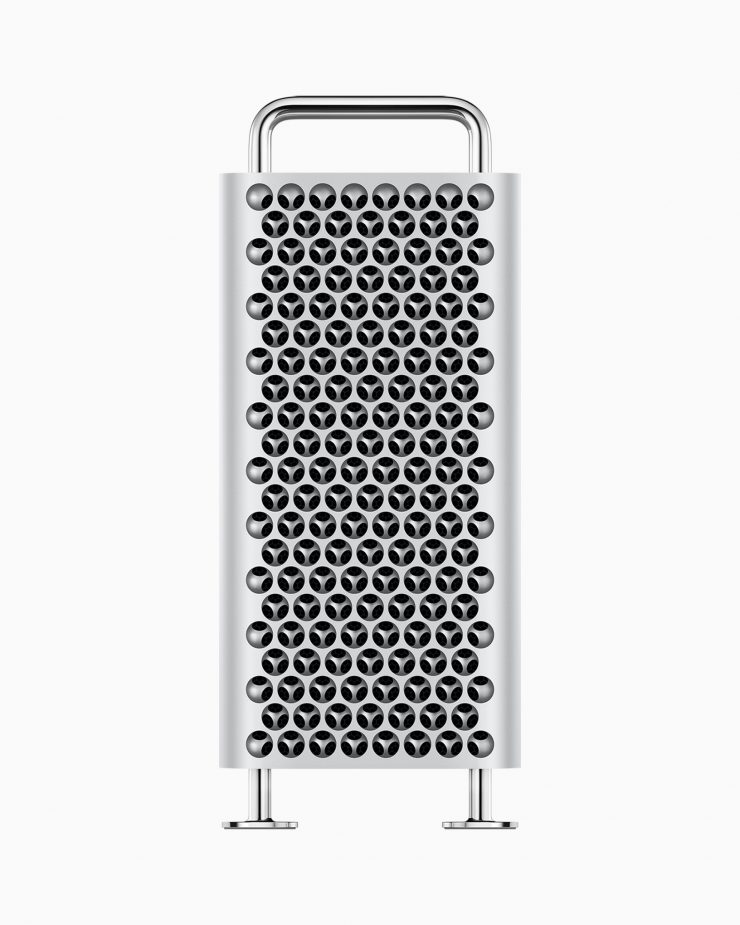
Key capabilities & features of AMD Radeon Pro Vega II GPUs
- Leading-edge compute performance – The AMD Radeon™ Pro Vega II GPU delivers up to 14 TFLOPS of single-precision FP32 performance and up to 28 TFLOPS of half-precision FP16 performance.
- Support for Infinity Fabric Link GPU interconnect technology – With up to 84GB/s per direction low-latency peer-to-peer memory access1, the scalable GPU interconnect technology enables GPU-to-GPU communications up to 5X faster than PCIe® Gen 3 interconnect speeds2.
- Ultra-fast HBM2 memory – 32GB of high-speed HBM2 memory delivers 1TB/s memory bandwidth, providing the memory capacity and data transfer speeds required by today’s high-resolution, multi-display setups, 8K video, and other demanding content creation workloads.
The new Mac Pro looks to be a beast and for 8K and heavy compositing and graphics work the new system is very upgradable. Choose the options that meet your demands.
The base Mac Pro will be an 8-core Xeon CPU, 32GB of memory, a 256GB SSD and have the Radeon Pro 580X graphics card for $5999 and go up from there.
The new Mac Pro will ship this fall 2019. A rack mountable version will also be available. I’m certain it will be well in the $10K range or more if you go with the most powerful options however the beauty of a tower is being able to upgrade later and third-party vendors will soon be making its options for the new Mac Pro.
Apple has a one half-width slot for its I/O card. The card has two Thunderbolt 3 ports, two USB-A ports, and a 3.5mm audio jack. Also two ethernet ports.
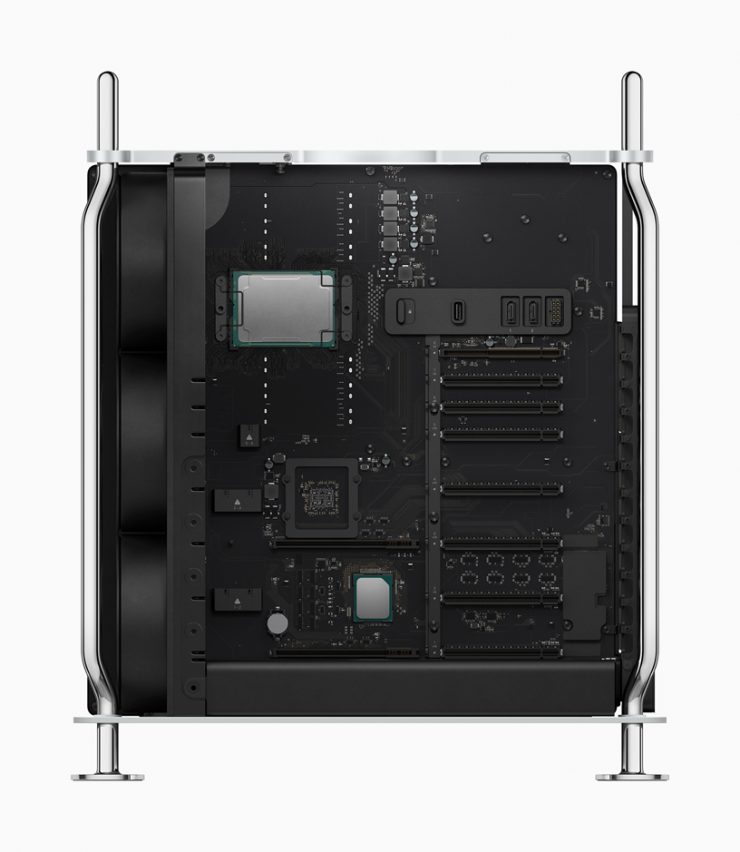
Storage
The new Mac Pro can handle up to 4TB of SSD storage in these configurations. Up to 2.6GB/s sequential read and 2.7GB/s sequential write performance. Storage encrypted by the Apple T2 Security Chip.
- 256GB SSD – One 256GB module
- 1TB SSD – Two 512GB modules
- 2TB SSD – Two 1TB modules
- 4TB SSD – Two 2TB modules
Input/Output
I/O card installed in the half-length x4 PCI Express slot with:
Two USB 3 ports
Support for USB-A (up to 5Gb/s)
Two Thunderbolt 3 ports plus two additional on the top.
Support for Thunderbolt 3 (up to 40Gb/s)
Support for USB-C (up to 10Gb/s)
Support for DisplayPort
Two 10Gb Ethernet ports:
Support for 10Gb Ethernet performance over copper cabling
Support for Nbase-T industry standard: 1Gb, 2.5Gb, 5Gb, and 10Gb Ethernet link speeds using RJ-45 connectors
It’s great to finally see a system like this from Apple. I was starting to wonder if it would ever happen but as you can see Apple put a lot of thought in the new Mac Pro’s design and I would say stepped up to what users have been asking for. Yes, the price will be high but if you make a living with your computer you need to have upgradability and the new Mac Pro looks to be delivering what users want.
Does this beast of a computer have you wanting to get one? I personally like my iMac 2017 Retina 5K, 27-inch a lot and it’s serving me well but when the time comes I feel I can finally choose a Mac Pro again.
But wait… There’s more. The 10 bit Pro Display XDR
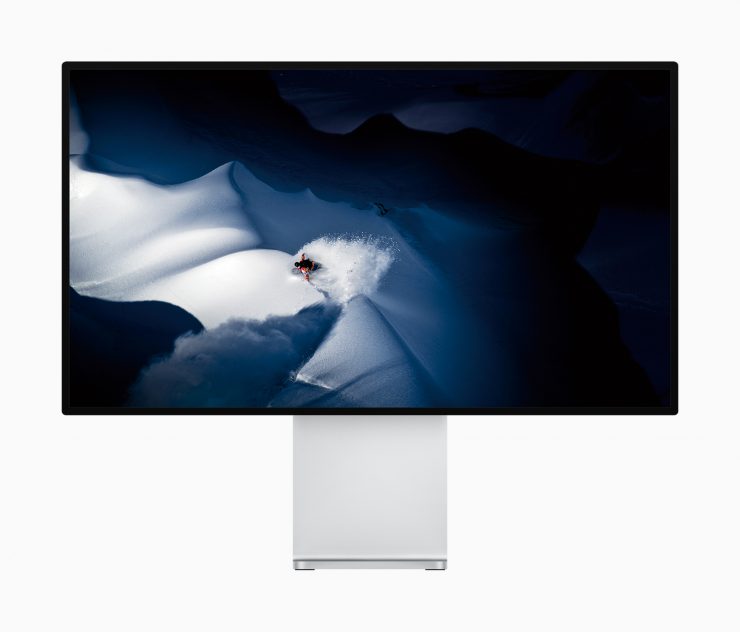
Apple also today introduced the Pro Display XDR monitor that equals the introductory price of the new Mac Pro. It’s $4999! Yes, that’s not a typo. In grand Apple fashion, the new true 10 bit Pro Display XDR comes with a lot of new tech but at a high price.
The Pro Display XDR features a 32-inch LCD panel with a 6016 x 3384 Retina 6K resolution with more than 20 million pixels, Pro Display XDR delivers a super-sharp, high-resolution viewing experience with nearly 40 percent more screen real estate than a Retina 5K display.
With a P3 wide color gamut and true 10-bit color for over 1 billion colors, pros will have a more true-to-life viewing critical for video and photo editing, 3D animation or color grading. Pro Display XDR also features polarizer technology, delivering a superwide, color-accurate, off-axis viewing angle. To manage reflected light, Pro Display XDR has an anti-reflective coating and offers an innovative new matte option called nano-texture, with glass etched at the nanometer level for low reflectivity and less glare.
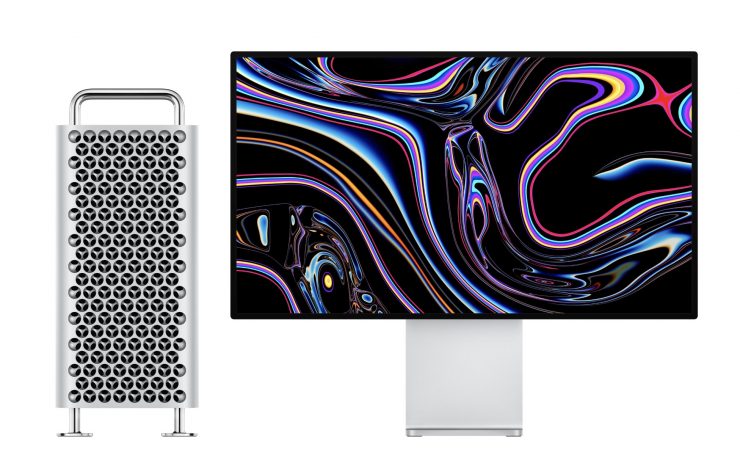
Extreme Dynamic Range
Pro Display XDR uses a direct backlighting system with a large array of LEDs that produce 1,000 nits of full-screen brightness and 1,600 nits of peak brightness, far surpassing that of a typical display.
With an advanced thermal system that uses its aluminum lattice pattern as a heat sink, Pro Display XDR can sustain 1,000 nits of full-screen brightness indefinitely, something that has never been possible before on a display at this price point. And with a 1,000,000:1 contrast ratio, images will have the brightest specular highlights, super dark blacks and all the details in between.
Apple Pro Display XDR starts at $4,999, the Pro Stand is $999 and the VESA Mount Adapter is $199. Yes, the stand alone is $1000.





